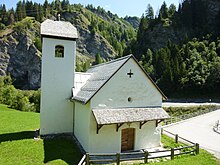Church of St. Lucius (Peiden)
The Catholic branch church of St. Luzius is in Peiden-Bad below the village of Peiden in the Valsertal in the canton of Graubünden .
history
The chapel was first mentioned in 1345 under its original patronage, S. Sigismund. It is not known when she moved to St. Lucius . The choir and probably also the tower were rebuilt in 1510, the crooked hip roof was built in the 18th century. Restorations took place in 1980 and 2000/01.
building
The nave, which is covered with a flat post-Gothic strip ceiling, is joined to the northeast by a choir closed on three sides, which is covered with a star vault. Late Gothic tracery windows are set into the choir, while Romanesque arched windows are in the right side wall of the nave. The Christophorus picture above the sloping roof on the front was painted over on the occasion of a renovation.
Furnishing
Of the three wooden altars, the right side altar is the oldest; it dates from 1666. The right side altar dates from around 1730, the high altar was built at the beginning of the 18th century. The bell comes from Gaudenz Hempel from Chur , was cast in 1683 and has a diameter of 43 centimeters.
Pietà
The group of figures of the Pietà is carved from linden wood, 110 centimeters high and 50 centimeters wide. Erwin Poeschel dates it to around 1360.
Until the time of the Reformation, until around 1530, the figure probably stood in Duvin's church . How she got to Peiden is unclear. The legendary version, according to which it was thrown into the ravine by the Reformed Duvins and fished out again by the Catholic Peiders in Glenner , is very unlikely in view of the numerous original parts that would certainly have been damaged during a river trip.
The figure stood in the church of St. Luzius for over 400 years. In the 1970s, Vicar General Giusep Pelican arranged for her to be transferred to the episcopal palace in Chur; because he believed her threatened by theft. Moving from the damp and unheated church to the dry and warm chapel vestibule had devastating consequences: the intensive drying process caused the wood of the sculpture to shrink, causing several layers of paint to peel off and peel off.
Vicar General Pelican commissioned the company Emmenegger & Sons in Zizers to restore the figure. After the first emergency backups, however, the Pietà remained in the Emmenegger depot for several years due to a lack of financial resources. Only in connection with renovation work in the church of St. Luzius in 2000/2001 did the parish of Peiden decide to have the restoration of the figure completed.
Investigations have shown that the right arm of Christ, the halos and the sword of pain in Mary's breast were added in the Baroque era , the other parts turned out to be original parts. The upper body of Mary was probably provided with vertical fold notches in the 15th century.
Six successive layers of paint were detected. The current version mainly shows layers of paint from the second and third version from the late Gothic period. The heavily damaged paint layer of the 19th century was sacrificed in favor of the late medieval one. Today the Pietà of St. Lucius is secured by a solid glass pane.
literature
- Erwin Poeschel : Art Monuments of the Canton of Graubünden , Volume IV, Birkhäuser Verlag, Basel 1942, p. 210
- Ludmila Seifert, Leza Dosch: Art Guide through Graubünden Scheidegger & Spiess, Zurich 2008
- Hans Rutishauser: The high Gothic Pietà from the St. Luzius branch church in Suraua-Peiden Bad , in "Archaeological Service Graubünden - Monument Preservation Graubünden"; 2001 annual reports
Web links
- Adolf Collenberg: Peiden. In: Historical Lexicon of Switzerland .





